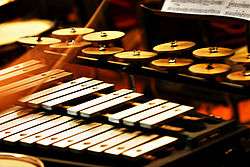Crotales
 | |
| Percussion instrument | |
|---|---|
| Classification | Percussion |
| Hornbostel–Sachs classification |
111.22 (Percussion plaques) |
Crotales (/kroʊˈtɑːleɪz/), sometimes called antique cymbals, are percussion instruments consisting of small, tuned bronze or brass disks. Each is about 10 cm (4 in) in diameter with a flat top surface and a nipple on the base. They are commonly played by being struck with hard mallets. However, they may also be played by striking two disks together in the same manner as finger cymbals, or by bowing. Their sound is rather like a small tuned bell, only with a much brighter sound, and a much longer resonance. Like tuned finger cymbals, crotales are thicker and larger; they also have slight grooves in them which give their sound more sparkle. The name comes from the Greek crotalon, for a castanet or rattle.
Modern crotales are arranged chromatically and have a range of up to two octaves. They are typically available in sets (commonly one octave) but may also be purchased individually. Crotales are treated as transposing instruments; music for crotales is written two octaves lower than the sounding pitch, to minimize ledger lines.
Crotal bells are a type of small bell, mostly medieval. A different form of crotal is found in Prehistoric Ireland. The National Museum of Ireland and British Museum have several examples on display dating from the late Bronze Age (800 – 800 BC) which were found in the Dowris Hoard, alongside various brass wind instruments. These are bronze cylinders in the rough shape of a bull's testicle, with a piece of baked clay or a pebble inside. It is presumed they functioned as a type of rattle. The hoard had 48 of them in total, in two sizes. Only two other examples are known, both Irish.[1]

Uses
One of the earliest uses of crotales in the orchestral repertoire is Claude Debussy's Prélude à l'après-midi d'un faune. Other classical pieces featuring crotales include Hector Berlioz's Symphonie Roméo et Juliette, and Maurice Ravel's own orchestration of his Alborada del gracioso.[2] In Igor Stravinsky's The Rite of Spring, the score calls for two crotales in A♭ and B♭, and his Les noces ends on a plaintive series of chords struck by a combination of chimes and crotales.
Another orchestral piece, From Me Flows What You Call Time by Toru Takemitsu, features crotales (as well as a host of other bells) in a prominent role.
In Joseph Schwantner's ...and the mountains rising nowhere, the composer calls for the instrument to be bowed with a double bass bow, producing an eerie, sustained glass harmonica-like effect.
Karlheinz Stockhausen's Mantra features pianists using crotales along with ring modulators and shortwave radio.
The contemporary American composer John Adams also uses them in many of his more colourful orchestral pieces such as Short Ride in a Fast Machine.[3]
Rock drummer Neil Peart uses crotales as part of his basic drum kit.
Progressive metal drummer Mike Portnoy used a crotales set in the Awake and A Change of Seasons era.
Jocie Adams of The Low Anthem plays the instrument in the bowed manner in their live shows.
Songwriter Rufus Wainwright uses the crotales to percussive effect in his song "Beauty Mark" from his self-titled debut album in 1998.
Mike Oldfield utilized crotales in Clear Light on his album Tubular Bells II, accompanying a synthesizer and guitar tune.
Glenn Kotche of Wilco uses crotales, most prominently in the song "I am Trying to Break Your Heart".
Crotales can be heard in "Wuthering Heights" by Kate Bush, played by percussionist Morris Pert.
Progressive rock drummer Alan White of Yes uses crotales in the middle instrumental section of Awaken from Going For The One.
References
- ↑ Wallace, Patrick F., O'Floinn, Raghnall eds. Treasures of the National Museum of Ireland: Irish Antiquities, 2002, Gill & Macmillan, Dublin, ISBN 0717128296
- ↑ Karl Peinkofer and Fritz Tannigel, Handbook of Percussion Instruments, (Mainz, Germany: Schott, 1976), 61.
- ↑ May, Thomas (ed.). The John Adams Reader: Essential Writings on an American Composer. Pompton Plains, N.J.: Amadeus, 2006. p. 108